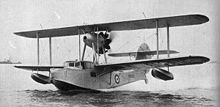
Summary
749 Naval Air Squadron (749 NAS) was a Naval Air Squadron of the Royal Navy's Fleet Air Arm. It was active from 1941 through to 1945, formed as an Observer Training Squadron, as part of No.1 Observer School at RNAS Piarco (HMS Goshawk)]], located 30 km (19 mi) east of Downtown Port of Spain, adjacent to the town of Piarco, on the island of Trinidad.
| 749 Naval Air Squadron | |
|---|---|
| Active | 1 January 1941 - 1 October 1945[1] |
| Country | |
| Branch | |
| Type | Fleet Air Arm Second Line Squadron |
| Role | Observer Training Squadron |
| Size | Squadron |
| Part of | Fleet Air Arm |
| Garrison/HQ | RNAS Piarco (HMS Goshawk) |
| Insignia | |
| Identification Markings | W2QA+ & W2QAA+ Walrus W2A+ & W2AA+ Goose A1-A4 Anson[2] |
| Aircraft flown | |
| Patrol | Supermarine Walrus |
| Trainer | Grumman Goose Avro Anson |

History of 749 NAS edit
Observer Training Squadron (1941 – 1945) edit
749 Naval Air Squadron formed at RNAS Piarco (HMS Goshawk), Trinidad, on 1 January 1941 as a Observer Training Squadron. The squadron's function, was the training of observers for the Fleet Air Arm and to achieve this, it was equipped with Supermarine Walrus, an amphibious maritime patrol aircraft and navigation training variant of the Grumman Goose amphibious aircraft. It formed part of the No. 1 Observer School, operating out of RNAS Piarco alongside two more Observer Training Squadrons: 750 Naval Air Squadron and 752 Naval Air Squadron, along with an Air Towed Target Unit, 793 Naval Air Squadron.[3]
The ocean liner and a refrigerated cargo ship, SS Almeda Star, left Liverpool carrying within its passenger complement, 142 members of the Fleet Air Arm to RNAS Piarco. They consisted of 21 officers and 121 ratings from 749 Naval Air Squadron, 750 Naval Air Squadron and 752 Naval Air Squadron. On 17 January 1941 Almeda Star was about 35 nautical miles (65 km) north of Rockall when the German submarine U-96, commanded by Kptlt Heinrich Lehmann-Willenbrock, torpedoed her. All 360 people aboard were lost.[4]
From 1942 the squadron was also tasked with anti-submarine patrols,[2] depth charges and flares were provided to these flights, until 1944, when US Navy forces took on this responsibility.[5]
749 Naval Air Squadron remained at RNAS Piarco for the duration of World War II, adding four Avro Anson multi-role training aircraft to its strength in 1954, however, it disbanded on 1 October 1945.[3]
Aircraft operated edit
The squadron has operated three different aircraft types:[3][5]
- Supermarine Walrus amphibious maritime patrol aircraft (January 1941 - October 1945)
- Grumman Goose Mk.IA[6] amphibious navigation trainer aircraft (March 1942 – October 1945)
- Avro Anson I multi-role training aircraft (June 1945 - October 1945)
edit
749 Naval Air Squadron operated from a single naval air station of the Royal Navy, located overseas in Trinidad:[5]
- Royal Naval Air Station PIARCO (HMS Goshawk) (1 January 1941 - 9 October 1945)
- disbanded - (9 October 1945)
Commanding Officers edit
List of Commanding officers of 749 Naval Air Squadron with date, month and year of appointment:[2]
- Lieutenant(A) J.C. Moore, RNVR, from 1 January 1941
- Lieutenant Commander(A) G.H. Winn, RNVR, from 1 December 1941
- Lieutenant commander(A) A.E. Worby, RNVR, from 7 April 1943
- Lieutenant commander(A) P.G. Lee, RNVR, from 1 August 1945
- disbanded - 9 October 1945
References edit
Citations edit
- ^ Sturtivant, Ballance 1994, p. 69.
- ^ a b c Wragg 2019, p. 123.
- ^ Helgason, Guðmundur (1995–2013). "Almeda Star". uboat.net. Guðmundur Helgason. Retrieved 2 May 2013.
- ^ a b c Ballance 2016, p. 52.
- ^ Thetford 1991, p. 434.
Bibliography edit
- Sturtivant, R; Ballance, T (1994). The Squadrons of The Fleet Air Arm. Tonbridge, Kent, UK: Air-Britain (Historians) Ltd. ISBN 0-85130-223-8.
- Ballance, Theo (2016). The Squadrons and Units of the Fleet Air Arm. Air-Britain. ISBN 978-0-85130-489-2.
- Thetford, Owen (1991). British Naval Aircraft since 1912. London, UK: Putnam Aeronautical Books, an imprint of Conway Maritime Press Ltd. ISBN 0-85177-849-6.
- Wragg, David (2019). The Fleet Air Arm Handbook 1939-1945. Cheltenham, Gloucestershire, UK: The History Press. ISBN 978-0-7509-9303-6.


